The massive red, white, and blue Croatian national flag affixed to a tall pole situated across the street from an ancient Catholic Church was flattened straight out against the blue sky like a piece of cardboard. It was a bad sign, much like the complete absence of any boats visible from our plane windows that morning as we’d crossed the Adriatic from Italy to Split.
I considered the bad omens at lunch as I sat with my husband at a table on the lee side of a four-hundred-year-old building on the Pjaca (old town square), sipping on a glass of crisp white wine and eating light crusty pizza. The wind whipping around us made for clear skies and spectacular views of crashing waves slamming into the marble boardwalk outside Diocletian’s Palace, but it was not the wind I wanted to feel. It didn’t matter that in the distance I saw a harbor full of catamarans and sailboats appearing like an apparition of appetizers, their masts so uniform in height they resembled hundreds of toothpicks stuck in tasty, yet expensive treats.
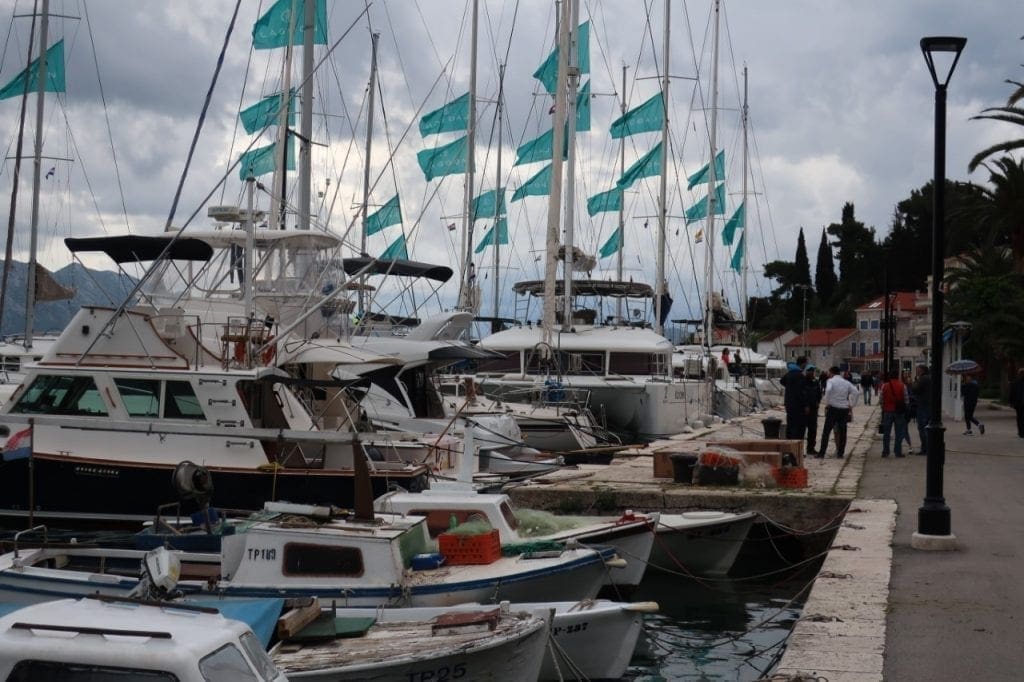 For the moment I stayed away from the marina so I wouldn’t hear the sounds of halyards flapping against the masts, the groaning mooring lines, or winds whistling through the rigging on the race boats. It would only increase my sudden well-founded anxiety…the Adriatic Regatta was to begin in a day and I was expected to be on board and ready to sail, no matter how strong the wind was blowing.
For the moment I stayed away from the marina so I wouldn’t hear the sounds of halyards flapping against the masts, the groaning mooring lines, or winds whistling through the rigging on the race boats. It would only increase my sudden well-founded anxiety…the Adriatic Regatta was to begin in a day and I was expected to be on board and ready to sail, no matter how strong the wind was blowing.
The next morning the wind mellowed, or perhaps I’d just became accustomed to it, and by the time we boarded our home for the next four days, I was ready to head to sea. It helped that all around us were the unmistakable signs of an impending sailboat race – regatta t-shirts from years past, foul weather jackets, and white-bottomed shoes. Our competitors observed us, the Americans, while we studied them. When I heard one man ordering a beer at breakfast, having stayed up partying the night before, I began to wonder if those of us who were eating omelets and drinking cappuccinos had the required grit for the regatta.
Our crew, accurately if not affectionately, called the Americans consisted of nine people – a Croatian captain (main guy), an American captain (my husband), the American/Romanian hosts Dragos and Kim, who invited us, and a mix of Romanian and American friends, which included me. Most were novices in sailboat racing or close to it, so Dramamine was pre-ordered – just in case. When I looked around the group not only did I think winning was an impossibility, I wasn’t sure we even had it in us to drink the thirty bottles of wine and other liquor on board – not exaggerating – in three days.
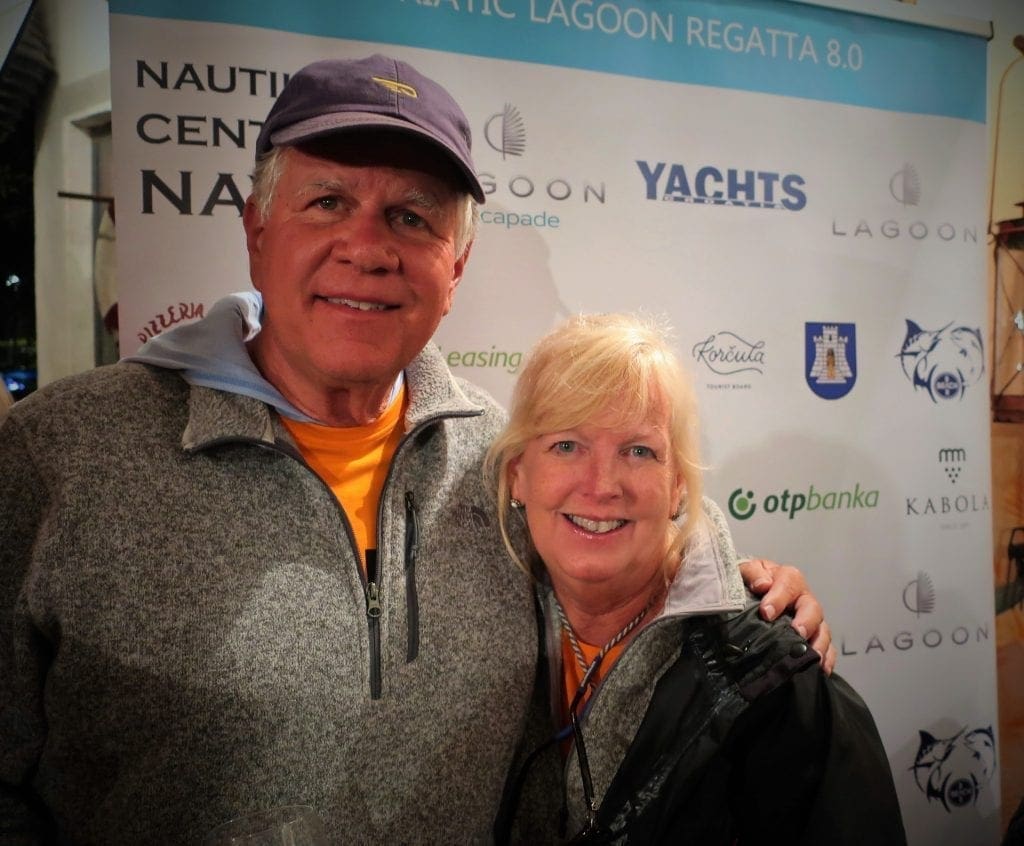 The Mustra 1, our 45 Lagoon, was spotlessly clean, fully provisioned, stainless gleaming, ready for the first test of the season, much like a racehorse at the start line. There would be fourteen more like us in the Regatta, give or take a meter or two. All participants were issued a t-shirt for each of the three days, complete with all-American movie sayings that only made sense in the regatta (“Frankly, my dear, I just wanna sail – Rhett Butler”) and a blue NAVA cap. If your cap flew away in the wind, another would miraculously replace it. If you wanted more food, fruit, toilet paper, whatever, it would appear. If your t-shirt was too tight, no problem. It was a pre-race production that ran like a well-oiled machine.
The Mustra 1, our 45 Lagoon, was spotlessly clean, fully provisioned, stainless gleaming, ready for the first test of the season, much like a racehorse at the start line. There would be fourteen more like us in the Regatta, give or take a meter or two. All participants were issued a t-shirt for each of the three days, complete with all-American movie sayings that only made sense in the regatta (“Frankly, my dear, I just wanna sail – Rhett Butler”) and a blue NAVA cap. If your cap flew away in the wind, another would miraculously replace it. If you wanted more food, fruit, toilet paper, whatever, it would appear. If your t-shirt was too tight, no problem. It was a pre-race production that ran like a well-oiled machine.
 RACE DAY ONE
RACE DAY ONE
Calm seas, clear skies, and phenomenal views greeted our sunglasses-covered travel-weary eyes on day one, perfect for the pre-race group photo. We were the first crew to line up for the shoot, a reward for clean living, but then, just like in America, a group of pretty young women arrived and were placed in front of us. We stood smiling out toward the sea as the photographer shouted instructions in Croatian, prepared to leave the minute we were released and the Captains finished their meeting. My husband informed us that all he could understand of that meeting was that this was supposed to be a “friendly race” – we weren’t to be colliding the expensive vessels into each other. That news sounded good to us, so we relaxed, applied sunblock, and waited for the race to begin.
But while we laid back in our slip in the harbor, the wind began to change. It whipped around to the north, quickly increasing to 25 knots. I saw the waves begin to froth – just in time for the race to start. Still, it was way past time for me to back out – the race was on.
That afternoon I discovered that any mono-hullers out there who doubt a regatta of Lagoon catamarans can be exciting would be seriously mistaken. They have never experienced anything like a catamaran under full sail screaming across the Adriatic from Split to the island of Hvar on a close reach. It was exhilarating to watch the massive hulls with identical weight, passenger count, and bottles of wine – fairer than most competitions – fight for seconds in time. Shockingly, we had a decent finish in our first race.
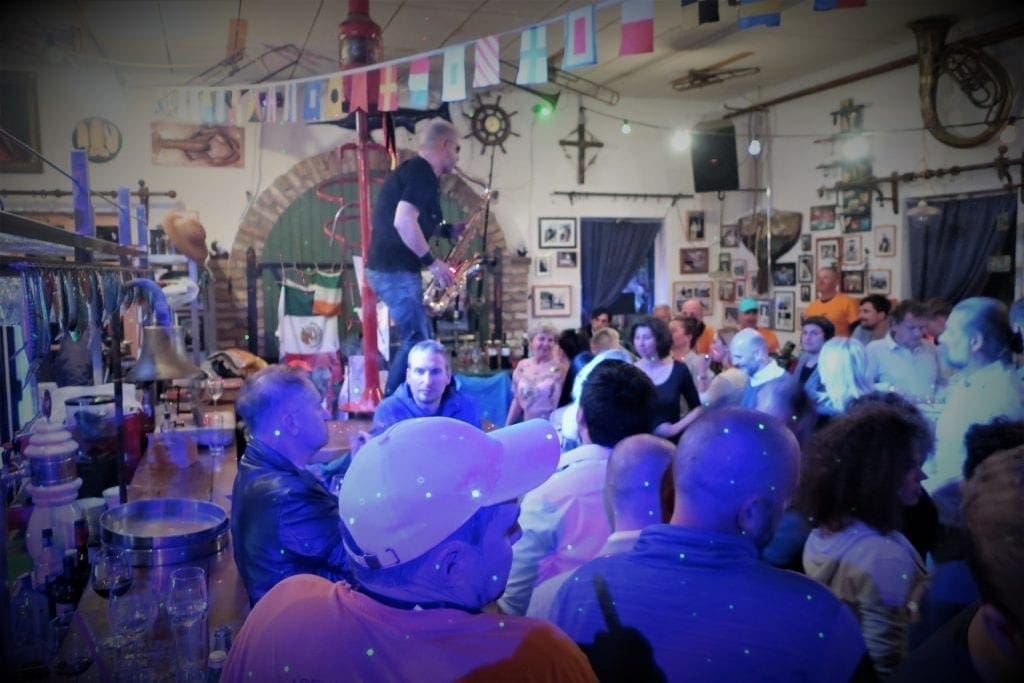 That night we moored in the picturesque harbor of Palmizana Island and dined at the Toto restaurant, high up on the hill overlooking our fleet of catamarans, now still and empty, tethered to their moorings. There was only one thing that could dampen our ebullient moods as we dined upon a nine-course meal with everything from octopus salad to shrimp, fish, tuna pate, and ravioli, plus endless wine. Only one thing could cloud the starry sky and dim the lights strung through the trees.
That night we moored in the picturesque harbor of Palmizana Island and dined at the Toto restaurant, high up on the hill overlooking our fleet of catamarans, now still and empty, tethered to their moorings. There was only one thing that could dampen our ebullient moods as we dined upon a nine-course meal with everything from octopus salad to shrimp, fish, tuna pate, and ravioli, plus endless wine. Only one thing could cloud the starry sky and dim the lights strung through the trees.
It was the daily rankings – we didn’t come in first!
Our captain and host knew better – we considered ourselves robbed. This was war and I knew only one way to get even. I told the DJ to turn up the ubiquitous American music they always play at events in Europe and we began to sing loudly, and mostly off-key, every word of every song as we danced the night away. Who were the losers now?
The next morning, we were still smarting from the international rebuke and headed up the hill, higher than Toto’s, into the lush Meneghello Estate forest of flowering trees and stone paths interspersed with artwork and sculpture gardens, only to discover another more remote restaurant, empty but for one other couple and the radiant smile of the lone hostess/waitress. Surrounded by the owner’s and her friend’s brightly colored artwork, no menus or hurry, we ordered what was undeniably one of the most memorable breakfasts of my life.
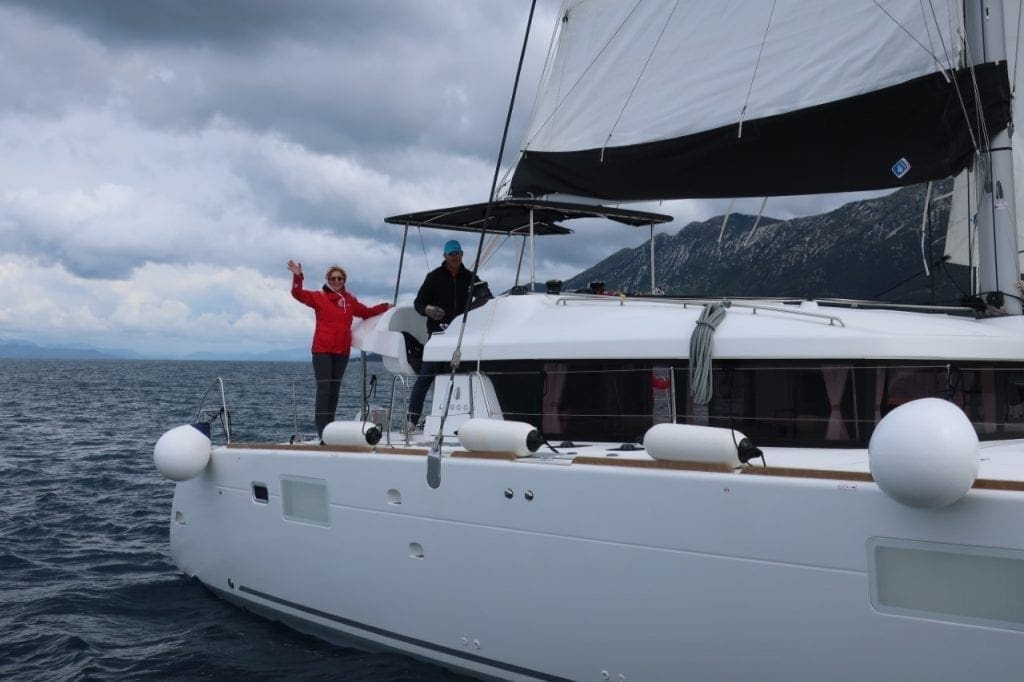 But healing from a bad ranking takes time. That’s why I couldn’t help myself when I noticed one of our competitors taking a shower on the stern of his boat in his bathing suit. We decided he had to be Russian – it was that unexpectedly cool of a morning. I motioned for him to dive into the icy water, holding my arms covered in a heavy sweater high above my head to make sure the meaning was clear.
But healing from a bad ranking takes time. That’s why I couldn’t help myself when I noticed one of our competitors taking a shower on the stern of his boat in his bathing suit. We decided he had to be Russian – it was that unexpectedly cool of a morning. I motioned for him to dive into the icy water, holding my arms covered in a heavy sweater high above my head to make sure the meaning was clear.
He had no intention of jumping, much less diving – at least until his fellow crew members realized what this meant – manhood, superiority, and the entire reputation of their vessel. They too joined into our gentle goading, so much so that just when I thought the man in blue swim-shorts was too smart to jump, he dove from the top of the deck into the frigid morning waters, much to our astonishment. When his head bobbed up above the surface of the clear waters of the cove we released our breath and gave him a hearty round of applause for his sacrifice. He was far braver than us.
I resolved to be more careful with my dares in the future.
SECOND SET OF RACES
One of the things about a “friendly race” on a non-racing boat is that it has many manifestations, including some technicalities that are utterly confusing in a foreign language. It was on Day Two that I learned most of them. It would have been more helpful on Day One. Regardless, here they are:
The VHF radio on our Lagoon automatically switched from Channel 77, the channel used for race alerts, to Channel 16 whenever there is a weather alert and you must manually reset it.
It is really hard for anyone to count backward in a foreign language, especially for the starter who is tired late in the day. The aforementioned VHF was in the salon of the boat and the Captains and crew were perched at the helm, not able to hear the race countdown. My job was to relay to them the counts and any other VHF information about the start and finish that I could understand, which was almost nothing. It was a thankless job. “How could I be so wrong?” they would continuously ask from above when I would convey the wrong count. It wasn’t until that afternoon that I had a witness to the fact that the starter’s countdown occasionally went something like this: “10, 9, 8, 7, 4, 7, 6, 5, 4, 3, 2, 1”.
And, don’t even think about coordinating stop-watches and timed alarms. Trust me – starting is a fluid event in a “friendly race” and any one race can start many times over, forcing new count-downs. It has its own rhythms and we discovered it is far easier to just go with the flow.
 MAGICAL KORCULA
MAGICAL KORCULA
Dinner on day two was in romantic, enchanting Korcula. Devoid of the throngs of tourists who come in the summer, Marco Polo’s hometown was a photographer’s dream, the late afternoon sunlight probing the stone city wall, narrow alleys, and the towering church steeple. We enjoyed a pleasant low-key gourmet dinner that night in a small restaurant with two other crews – one Russian and the other from Norway.
But that was only after we were treated to grappa and a performance of the Moreska, a Croatian war dance that dates back to 1150 and the Moorish invasion. With an all-male dance cast, half-dressed as Moors and half as Croatians, the production was part acting and part dancing, with a strong emphasis on fencing with heavy short swords. We were warned that it was dangerous to sit on the first row of seats on the auditorium floor. I found the advice to be well-founded when I witnessed the intensity of the two warring sets of dancers carrying stunted steel swords with a wicked curve at the end in each hand and dressed to the hilt in intricately decorated satin and lace costumes.
Each precise athletic and melodic movement, in which one circle of Croatians revolved and danced around the other set of Moors with swords clashing up and down in an elaborately choreographed battle, was timed to perfection. Even I knew that one slight miss with the sword and a dancer could be de-capitated and they all would fall like dominoes. It was, in fact, so dangerous that I wondered what happened to the poor souls who tried to join the Moreska dance for the honor to dance, but somehow failed to make the cut – were they still alive?
The first rainstorm of the trip fell upon us later that night as we exited the city walls toward the marina. Our crew opted to forego a visit to a nightclub later that night. Back at our floating home, we shed foul weather gear and wet clothes, crawled into our warm berths, tired and contented, and dreamed of the days long past on the tiny jewel of an island.
 THE FINAL RACE
THE FINAL RACE
Sunlight streaming through the open port-holes awakened me early the next morning. Leisurely cappuccinos and pastries at a nearby café, along with hot showers at the marina, set the pace for the morning – a well-received slow start. It would be close to noon before the final race began, this leg from Korcula to Trnjani, a tiny town of 871 residents on the water’s edge of the Peljesac peninsula, known worldwide for its great vineyards.
Finally, I was on top of the starting counts, but the topography of nearby land and clusters of boats made it difficult to sight the exact starting line. Another helpful lesson – bring your high-quality binoculars. Fearful of a false start, we luffed our jib until we saw the other boats begin to clear what must have been the starting line. Our hesitancy until everyone else began to sail ensured another bad start, made worse by a faint following wind. Anxious to increase our speed, we were the first boat to go wing-on-wing, but within a few minutes, the entire fleet was butterflying in the general direction of the first mark. It was a beautiful sight as the flutter of boats inched slowly ahead, with solitary crew members deftly trying to hold wind in the jibs. Then, like they always do, within an hour of the start, the wind gods re-appeared…but this time they were cruel – the wind direction would be in our faces as the catamarans beat to the finish line.
The second leg of the race was defined by speed, close-hauls, and tight tacks – conditions that allowed us to quickly catch up to our competition. Eventually, the Mustra 1 was sailing neck and neck with the leaders and our crew saw the opportunity to place in the race with a bit more strategy and effort. We began cheering on the captains and navigators like fans in a national football game.
But we weren’t alone. Just as they had the whole weekend, our two closest competitors were doing the same – giving us an epic fight to the finish, until suddenly things changed. Right at the finish line a miscalculation between the other two boats over a very complicated “who has the right-of-way” question caused them to almost collide.
We watched as fenders were dropped between the boats just in time to minimize the impending collision. We held our breath until one dutifully altered course. That momentary lapse of their speed allowed us to cross the imaginary line between the regatta boat and the final red marker ahead of them, so close to the mark that we could touch it.
That night we partied in a restaurant/club on the sandy beach in Trnjani, while gentle, but cool rain fell around us, causing the harbor lights to be mirrored on the stone wharf. We danced to and with a sax player who looked like Anthony Bourdain, dined on freshly harvested flat oysters that my husband helped shuck, and consumed fresh tuna perfectly prepared every conceivable way – appetizers, sushi, tartar, steaks. It turned out the restaurant owner caught 110 kilos of tuna a few days before and this feast was the result.
When it was time for the final results and awards, celebrations for the Norwegians, Austrians, and one of the
Russian boats were raucous, but nothing like the cheers from the crowd for Dragos and Kim, who along with their captains and crew, led the unlikely Romanian-American crew to second place in our class.
After three days of racing, dining, and dancing, the international competitors had finally melded into one group – fledgling friendships and promises formed on the common interest of sailing. We promised to meet again. What can beat three glorious days with no TV, no politics, and no work – just days on end of sailing, racing, and fun?
“Frankly, my dear, I don’t know what could be better,” Rhett Butler.

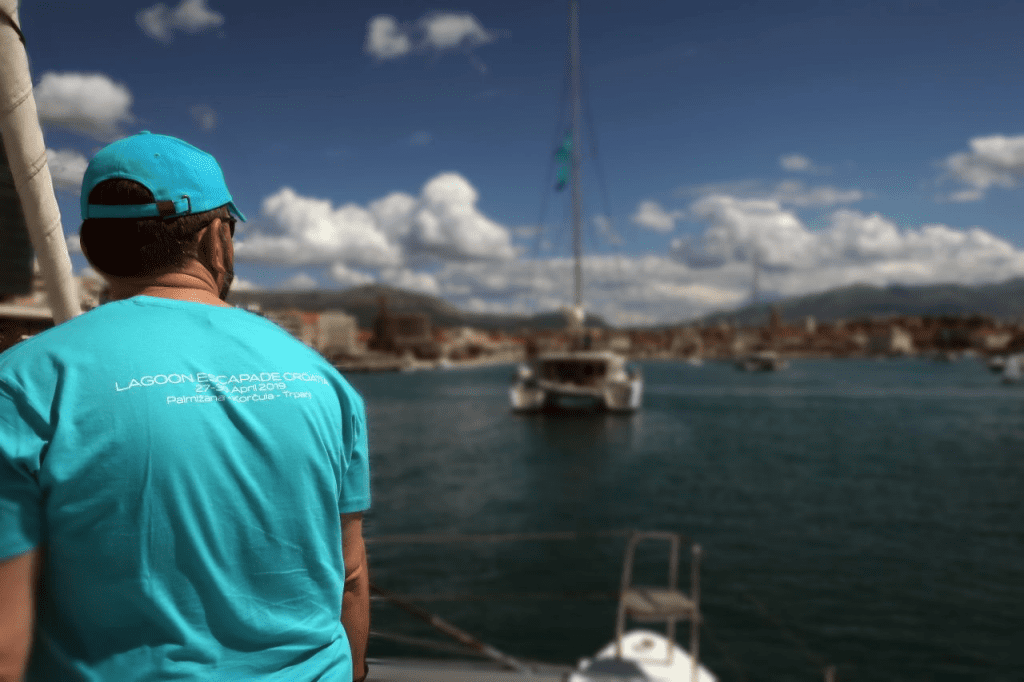 RACE DAY ONE
RACE DAY ONE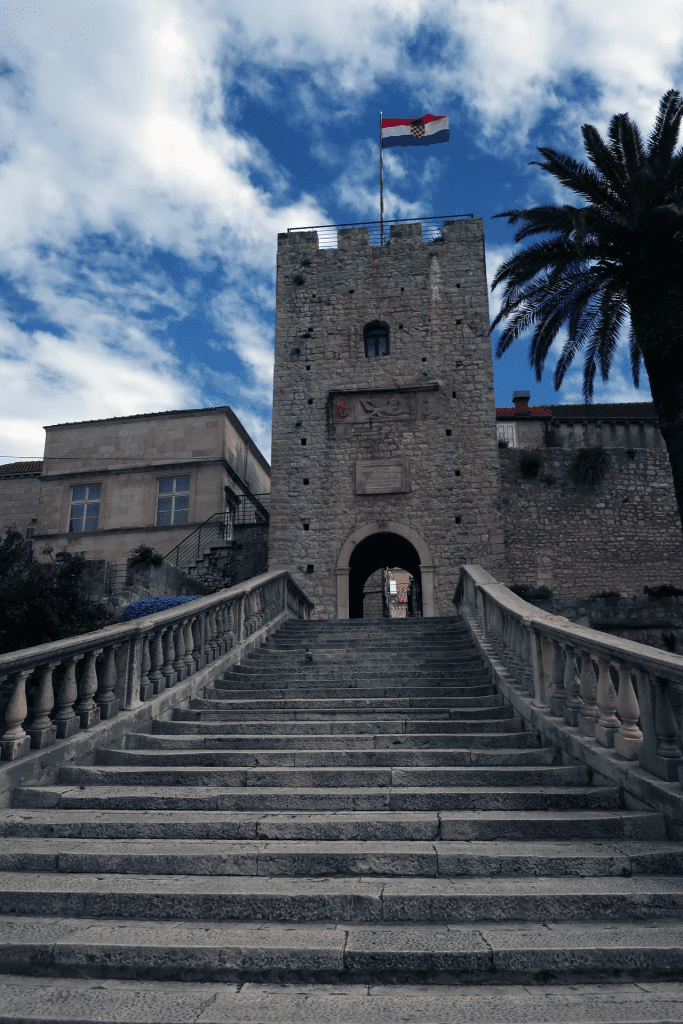 MAGICAL KORCULA
MAGICAL KORCULA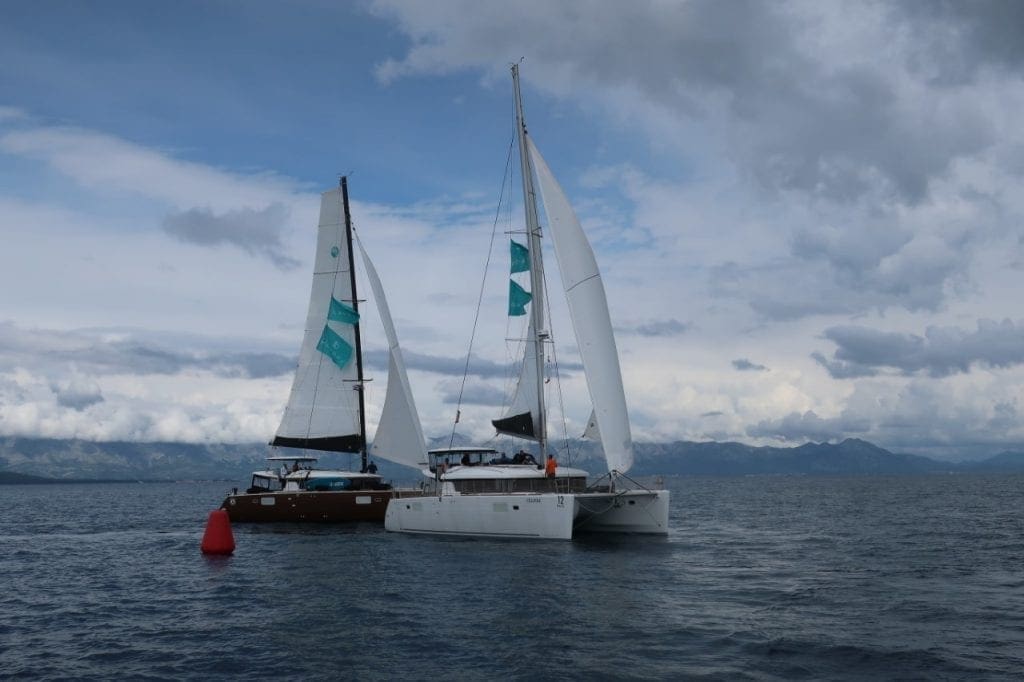 THE FINAL RACE
THE FINAL RACE
0 Comments